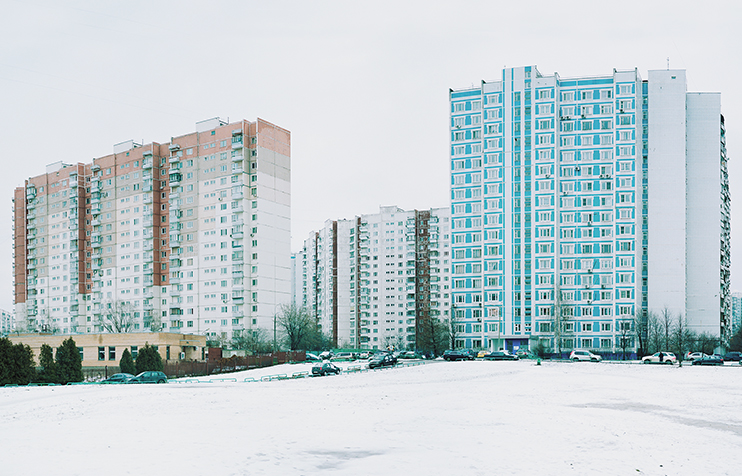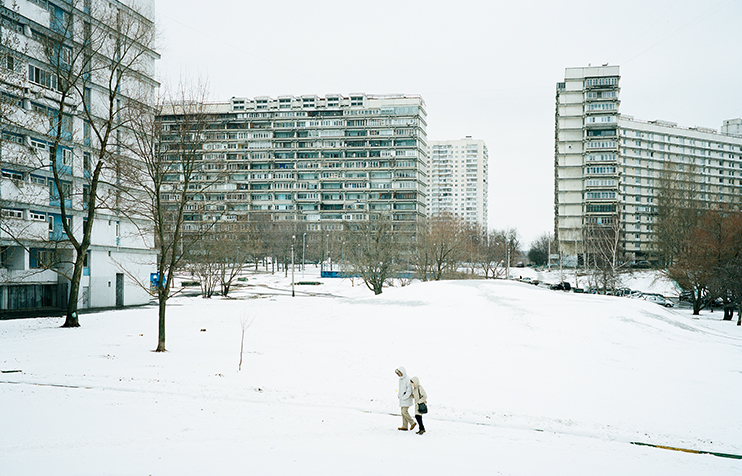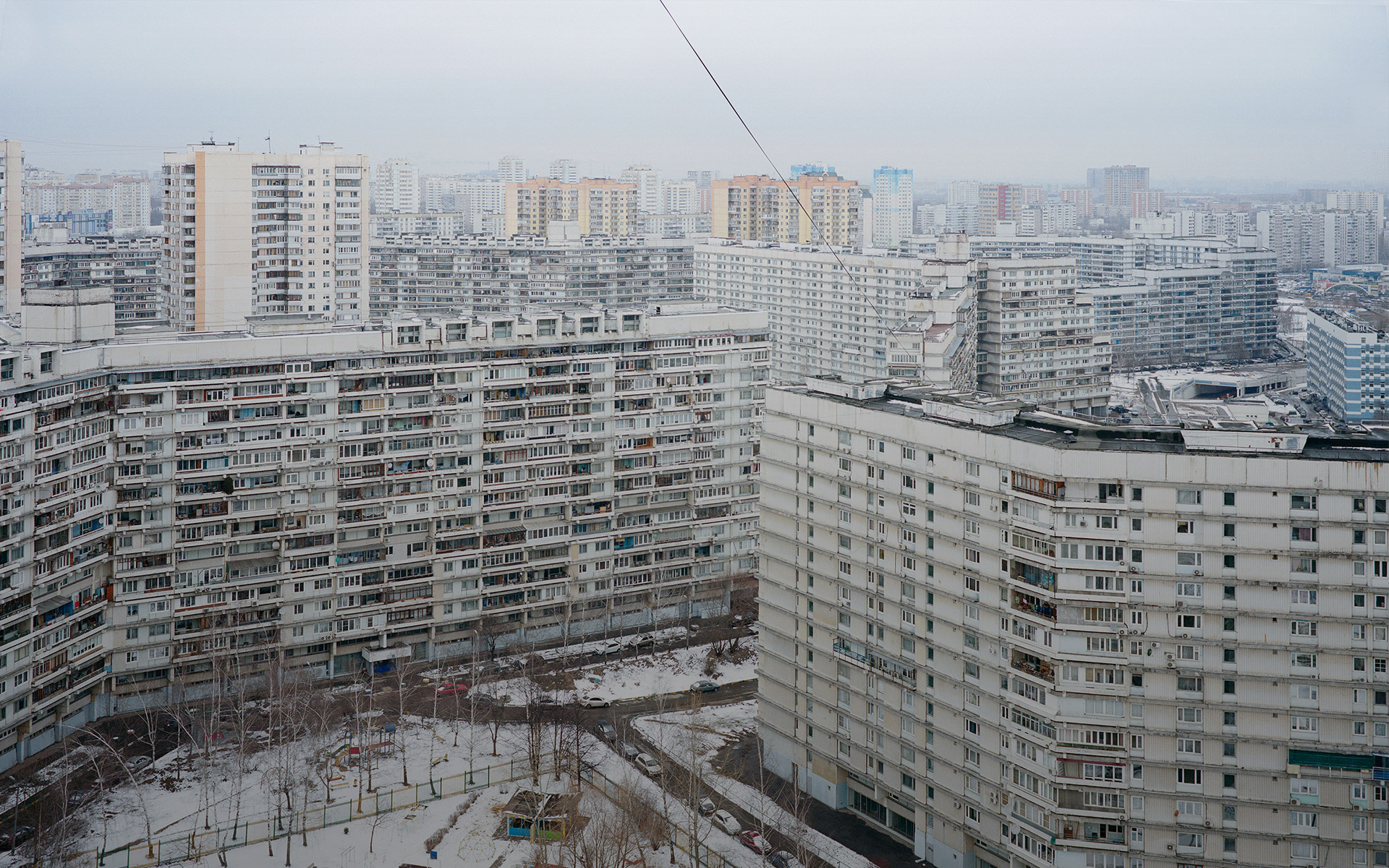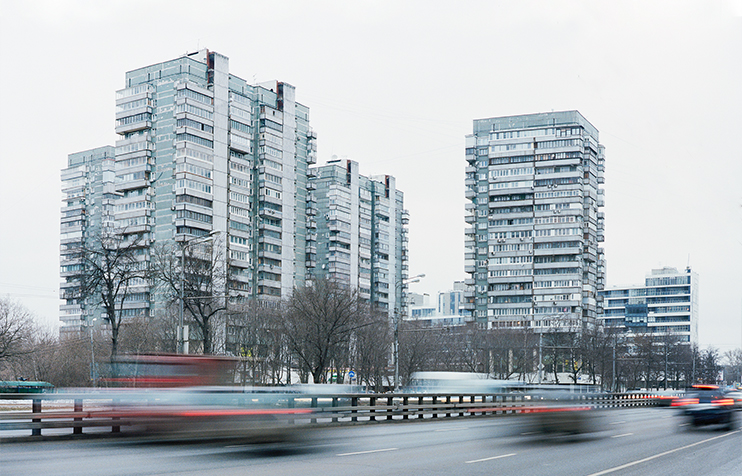The public square just off 60th Anniversary of October Street in the Moscow suburb of Novye Cheryomushki (New Cherry Town) is a very ordinary, if unusually placid, place. Trees, playgrounds, benches, mothers pushing prams and the odd middle-aged boozer circle around a small statue of Lenin. Beyond them, the four-storey apartment blocks look a little worn.
The sense of quiet torpor here is fitting given that Russians call their suburbs “sleeping districts” – not much more than cubicles to come home to at the end of a day’s work. Yet Novye Cheryomushki is certainly one of the more attractive places to sleep, and live, with low-rise buildings, lots of social facilities, and a metro station nearby. It is also the common ancestor of every mikrorayon (micro-district) in Moscow; the forefather of nearly every suburb in the capital and far beyond.
For the centre of Novye Cheryomushki bears witness to an extraordinary architectural competition between seven blocks of flats. Each of these seven blocks, built in 1958 at record speed, employs a different prefabricated construction system, usually of concrete panels slotted into place like toy building blocks. Each was assessed on expense and speed of construction, and then one lucky block of flats, codenamed “K7”, was chosen as the winner.
K7’s reward was to be replicated in the hundreds of thousands, possibly millions, all across the Soviet Union. Thus began the largest experiment in industrialised housing in history, where homes would become mass-produced commodities like cars, fridges and TVs. Industrialised housing made up 75% of all Soviet housing stock by 1991 – this is where the overwhelming majority of Muscovites live; not in the Tsarist-Stalinist oligarchgrad within the inner city, nor the hipster enclaves of Chistye Prudy or Gorky Park. These suburbs may look monolithic, but the stories they tell are not.
The programme was necessitated by the housing catastrophe that the Soviet Union faced by the 1950s. The Russian Empire was 80% rural in 1917, but under Stalin the fastest and probably most brutal industrial revolution in history was forced through between 1929 and 1940. Moscow filled with rural migrants fleeing a famine-ridden countryside to work in the new factories. Many lived in barracks, basements, tents, even trenches. This housing crisis was barely under control when the war compounded the problem, with the Third Reich’s war of extermination against the USSR making millions homeless.
However, attempts to redress this under Stalin were almost whimsical. Grandiose, richly decorated apartment blocks were built lining wide, Haussmannesque boulevards; enormous resources were diverted into skyscraping luxury hotels, or grace-and-favour flats for artists and bureaucrats. The first independent act of Nikita Khrushchev after becoming General Secretary on Stalin’s death was to force through a decree “On Architectural Excess”, demanding industrialised construction rather than bespoke masterpieces as a means of solving the crisis.
The solution began just to the south of Moscow, in the former village of Cheryomushki. Vast neoclassical apartment blocks still line the main roads here – talking about living in one of these Stalin-era apartments, architectural student Konstantin Budarin says “they fulfil my idea of dignity”, with their high ceilings and grandeur. However, the money for the more flamboyant features clearly soon ran out — decorative pilasters stop half-way up or are outlined in brick; grand archways lead to scuzzy courtyards.
The contrast between the Stalinist boulevards and the first parts of Novye Cheryomushki is striking. Around Akademicheskaya metro station, the apartment blocks are lower and simpler, and the inbetween spaces are full of fountains and benches rather than afterthoughts behind grand facades. When first built, Novye Cheryomushki also featured an abundance of public space and public buildings: health centres, creches, schools, cinemas, libraries, theatres and clubs.
An instant prefabricated community on this scale had not been attempted anywhere in the world, and visitors flocked to see it
It’s difficult to exaggerate just how huge a social advance this was for Muscovites; not only in the sense of amenities, but also in that a private life was now possible, after three decades where the majority had been living in cramped communal flats, one family to a room or worse.
Initially, each mikrorayon was planned with all of this included, all to equally standard designs. An instant prefabricated community on this scale had not been attempted anywhere in the world, and visitors flocked to see it. Shostakovich composed an operetta titled after the district, satirising Muscovites’ desperate desire to move there; it was adapted into a colour film in 1963. Built in the year of Sputnik, it seemed to suggest the Soviet way of doing things — an egalitarian, centrally planned, mass-production economy — was getting results.
And a certain nostalgia for those days still pervades — we visited on Mayday, when residents were enjoying the day off and public billboards were stuffed with Soviet-nostalgic paraphernalia, or posters for the upcoming Victory Day (though that sort of bombast felt rather incongruous in this easy, sociable space).
Each mikrorayon was meant to have a factory, an institute or both; the risk that they would become dormitory suburbs was realised early on, and here, at least, it was partially prevented. Around the Novye Cheryomushki metro station are several research institutes, moved or founded here in the 1960s.
Cheryomushki was not just a “sleeping district” but a hub of the USSR’s scientific-military-industrial complex: the centrepiece was the Institute of Scientific Information of Social Sciences Library, the Soviet equivalent of the Library of Congress, reached from the street by a concrete bridge over a (long-since drained) lake. Adjacent is the tower of the Central Economic Mathematical Institute, one of the drivers of the Soviet central planning system — a glass grid by architect Leonid Pavlov with a colourful mobius strip sculpture set into the middle floors.
Each mikrorayon was meant to have a factory, an institute or both; the risk that they would become dormitory suburbs was realised early on
The shift of the urban economy from production to speculation has invaded this carefully arranged space in recent years and smashed up its order, with a dozen 30-storey towers with pitched roofs crashing into the open space around, creating a looming, claustrophobic feel; the sense that planning has been abandoned here and it’s everyone for themselves.
Indeed, Moscow’s suburbs have faced extreme levels of “infill” development in the last 10-15 years, with immense towers shoved into the parks and gardens of the mikrorayons, throwing flats into darkness and obliterating the communal amenities. One new tower is even crammed into the small square between the Central Economic Mathematical Institute tower and the Institute of Scientific Information on Social Sciences Library, blocking out its light.
The latter suffered a catastrophic fire in January, described by the head of the Academy of Sciences as the academic equivalent of the Chernobyl disaster. Over a million priceless volumes were damaged. The fire was ascribed to an electrical fault, but given the intensity of development around it, it doesn’t take a conspiracy theorist to suspect foul play. You could easily imagine the original attempts at making this something more than a suburb being erased in a decade or two, as it is turned into a commuter district like any other.
Belyayevo
Novye Cheryomushki’s pioneering status makes it a little different from the Soviet norm. That begins a couple of stops south on the metro, at the mikrorayon of Belyayevo, developed from the 1960s onwards. This really is a quintessential “sleeping district”. From hereon, the original notion of self-contained districts with their own identity was watered down as a numbers game took over.
The “winning” square panel at Cheryomushki is extended here into long slabs, tall towers and squat maisonettes – unrelieved by any variation or individuality whatsoever, without an obvious centre, and with relatively sparse social facilities compared to its predecessor.
Off the main road, where they survive, the green spaces are Belyayevo’s saving grace; enclosing schools, ponds and park benches. This seems like a place where it would be great to be six — there’s loads of free open space and playgrounds to play in — and a boring place to be 16.
“It’s dark and scary here, can we go back to our Belyayevo where everything is green and open?”
Belyayevo has, though, become a minor cause celebre after the Moscow-based Polish architect Kuba Snopek submitted it to Unesco as a potential entry on the World Heritage list, on the basis that most of the Moscow Conceptualists — artists and thinkers such as Boris Groys, Dmitri Prigov and Ilya Kabakov — lived and worked here in the 1970s. Their famous 1974 Bulldozer Exhibition, broken up by police, took place in one of Belyayevo’s empty spaces.
The idea of listing the district is, of course, akin to one of the Conceptualists’ knowing jokes: to argue that the true “hipster” district of Moscow, the real “arts incubator”, was a mundane concrete suburb. Nonetheless, it is still part of the capital with all its draws, its centre reachable easily from the Metro.
Indeed, one of Belyayevo’s resident artists described taking his young son to the historic centre of Moscow for the first time, and getting an unexpected response: “It’s dark and scary here, can we go back to our Belyayevo where everything is green and open?”
Severnoye Chertanovo
There are thousands of Belyayevos, but there is only one Severnoye Chertanovo. You can tell something is different as soon as you get off the metro here; while the stations in Belyayevo and Cheryomushki are as standardised as the housing, Chertanovskaya station is a return to the strange, opulent dreamworld created under Moscow during the Stalin era. Architect Nina Alyoshina’s hall is a moodily-lit expressionist cathedral that speaks of arrival at somewhere special, not of departure to the centre.
Outside, apartment blocks spread around a large lake. Half of these are standardised in the Belyayevo mould, but the other half are mid-rise buildings arching around artificial hills and valleys, connected by glazed skyways. Looking closely, you can see they’re also made of standardised panels, but arranged in such a way to give variety to the buildings; this is the first of the mikrorayons where you can really speak of “architecture” rather than just engineering.
Photographer Yuri Palmin has lived in Chertanovo for 18 years — first in what he calls the “bad”, standardised blocks; then in the more prestigious, bespoke blocks opposite. He points out that the area not only looks unlike the other mikrorayons, it has a totally different layout. Rather than the interchangeable units for nuclear families, there are “42 different kinds of single- and double-level flats, with winter gardens in the ground floors” within these long complexes.
New apartment blocks built into the interstices of the mikrorayons since then are still industrialised; still pieced together from concrete panels
This was a late attempt under Brezhnev to show that “developed socialism” could have room for different kinds of families and lives: “a sign of hope, a training ground and a lab”. After getting the population out of overcrowded, subdivided communal flats and into purpose-built apartments with their own front doors, the planned economy could finally move from “quantity” to “quality”. Except that this transition never happened on a large scale, and the standardised apartment blocks were being rolled out to the edges of Moscow up until the end of the 1980s.
It is often assumed that standardisation was ended by the capitalist “shock therapy” that was applied to Russia’s planned economy in the early 1990s. Yet new apartment blocks built into the interstices of the mikrorayons since then are still industrialised; still pieced together from concrete panels — albeit with silly decorative roofs to give a shallow impression of individuality. Even the Orthodox church built near the lake in the late 1990s is standardised in its thin, tacky application of old Russian details.
What has changed, however, is two things: space, with communal areas now regarded as parcels of land ripe for development, and speculation, with a vibrant property market in the capital generating fortunes for a few and insecurity for most.
Dominating Severnoye Chertanovo today is a 40-storey monolith called Avenue 77. According to Palmin, this giant apartment block limits light for many residents here for much more than “a few hours in summer”. It tries to break up its enormous grid of standardised flats via a Koolhaas-like “iconic” shape, but nobody could be seriously fooled; this is form following speculation, an image of public space and equality being crushed by speculation.
In the 1990s, when looking at the apparently interchangeable districts produced by Communism, critics didn’t see, or ignored, the libraries, the childcare centres, the parks and the treatment of housing as a basic and free human right; and instead saw merely those huge, inescapable, interchangeable monoliths – the slabs upon slabs that always strike the casual viewer driving from Moscow’s Domodedovo airport to its centre. These critics argued that this monumental uniformity was the greatest possible indictment of the system: a rigid plan that assumed everyone wanted the same thing, while giving them a mass-produced product that few really desired.
The assumption was that the free market would result in variety, liveliness and complexity. What actually happened was a property boom that took over Russia’s three or four biggest cities, and a grim decline everywhere else.
And how did they build for that boom? In Moscow’s city centre, some specially-commissioned edifices speak of the rarefied or outre tastes of the new elite – but in its suburbs, the main change was simply that apartment blocks became bigger, longer and more careless of public space. They were still, though, built via the methods that the newly privatised construction companies had learnt well in the “good old days”.
The ideals of Novye Cheryomushki may have died, but its methods and techniques remain — having managed to make some people very wealthy. Moscow suburbia is not so much the remnants of a great experiment, perhaps, but suburbia like any other suburbia — a place of dreams and boredom, great ideas being implemented and then slowly crushed.
This article is part of Moscow week, a special project run in association with Guardian Cities and the New East network.
Text: Owen Hatherley
Image: Egor Rogalev



